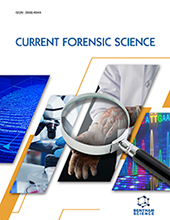Abstract
Background: Two cases involving father-daughter incest, a rare report in the Indian population, have been analyzed in the current study. STR markers on both autosomal and sex chromosomes were employed to expound the cases.
Objective: The objective of this study is to confirm the identity of the fetus as a product of father-- daughter incest and to study the inheritance pattern of alleles in such cases.
Methods: Autosomal, X, and Y chromosomal analyses were performed to confirm the identity of the fetus. Statistical analyses were carried out to strengthen the evidentiary value of the obtained results.
Results: In both cases, the aborted fetus was found to be the product of an incestuous father-daughter relationship. The probability of paternity as well as maternity was found to be >99.9999% in both cases. Analysis of other paternity and forensic parameters also substantiated the inclusion of the alleged individuals. Father-daughter incest had a tremendous effect on the genome as evidenced from the dramatical decrease in unrelated alleles between father/child [16.66% (Case 1), 20% (Case 2)] and mother/child [26.66% (Case 1), 21.66% (Case 2)]. Genetic evidence also suggested an increased biallelic match i.e., 26.66% (Case 1) and 33.33% (Case 2) between mother and fetus, which are at par/ above the normal siblings’ values i.e., 26.66%.
Conclusion: A significant increase in the percentage of homozygous alleles (53.33% in both cases) was observed in the product of father-daughter incest. Both daughters share the same X chromosome from the father, which also suggested the case to be of father-daughter incest. Similarly, the same Y-STR profile between the male fetus and alleged father confirmed the correct pattern of inheritance of the Y chromosome in this case.
Keywords: DNA Fingerprinting, Father-daughter incest, STRs, Paternity Index (PI), Power of Exclusion (PE), Combined Random Men Not Excluded (CRMNE).
[http://dx.doi.org/10.4103/0971-6866.38981] [PMID: 21957354]
[PMID: 12808731]
[http://dx.doi.org/10.1002/(SICI)1096-9896(199603)178:3<239::AID-PATH506>3.0.CO;2-5] [PMID: 8778326]
[PMID: 11387629]
[http://dx.doi.org/10.1111/j.1537-2995.2004.04092.x] [PMID: 15383026]
[http://dx.doi.org/10.1016/j.jcfm.2005.03.010] [PMID: 16310400]
[http://dx.doi.org/10.1007/s00414-014-0984-2] [PMID: 24711016]
[http://dx.doi.org/10.1016/S0001-4079(19)34262-1] [PMID: 12587337]
[http://dx.doi.org/10.1176/appi.ajp.160.2.369] [PMID: 12562587]
[http://dx.doi.org/10.1155/2016/4010187] [PMID: 28050302]
[http://dx.doi.org/10.1016/j.jflm.2015.08.005] [PMID: 26320005]
[http://dx.doi.org/10.1016/S0140-6736(11)60201-8] [PMID: 21315943]
[http://dx.doi.org/10.1016/S0531-5131(02)00393-X]
[PMID: 21258293]
[http://dx.doi.org/10.1016/j.fsigss.2007.10.080]
[http://dx.doi.org/10.1186/s40064-015-1364-1] [PMID: 26543701]
[http://dx.doi.org/10.1590/S1415-47572013000400008] [PMID: 24385853]
[http://dx.doi.org/10.4172/2155-9929.1000281]
[http://dx.doi.org/10.3126/medphoenix.v1i1.17889]
[http://dx.doi.org/10.1520/JFS2002236] [PMID: 14979352]
[http://dx.doi.org/10.15272/ajbps.v4i37.621]
[http://dx.doi.org/10.1007/s00414-006-0080-3] [PMID: 16514543]
[PMID: 12808726]
[PMID: 18274159]
[http://dx.doi.org/10.1111/j.1556-4029.2009.01015.x] [PMID: 19302381]
[http://dx.doi.org/10.1515/CCLM.2007.276] [PMID: 17727308]
[http://dx.doi.org/10.1111/j.1537-2995.2005.04271.x] [PMID: 15752164]
[http://dx.doi.org/10.1016/j.ics.2005.09.074]
[http://dx.doi.org/10.1016/j.jgeb.2012.05.001]
[http://dx.doi.org/10.4238/2014.February.27.2] [PMID: 24634174]
[http://dx.doi.org/10.1093/bioinformatics/btn608] [PMID: 19029128]
[http://dx.doi.org/10.3325/cmj.2013.54.257] [PMID: 23771756]
[http://dx.doi.org/10.1007/s11033-014-3839-5] [PMID: 25416555]
[http://dx.doi.org/10.1046/j.1365-2540.2001.00792.x] [PMID: 11380660]
[http://dx.doi.org/10.1534/genetics.104.031617] [PMID: 15371359]
[http://dx.doi.org/10.1086/429864] [PMID: 15789306]
[http://dx.doi.org/10.1038/hdy.2016.20] [PMID: 27071844]
[PMID: 15920965]
[http://dx.doi.org/10.1080/00450618.2011.650209]
[http://dx.doi.org/10.1016/j.fsigen.2008.09.006] [PMID: 19083865]









